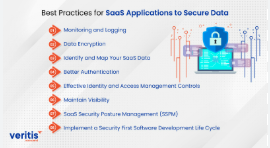Software as a Service (SaaS) has transformed the way businesses operate. From collaboration tools to customer relationship management (CRM) platforms, SaaS applications are now the backbone of modern organizations. However, as reliance on cloud-based applications grows, so do the security risks. Cyberattacks, data breaches, and compliance failures can compromise sensitive information, damage reputation, and cost millions.
That’s why learning how to secure SaaS applications is no longer optional—it’s a necessity. This guide explores essential strategies, best practices, and tools you can use to strengthen your SaaS security posture and protect business-critical data.
Why SaaS Security Matters
Unlike traditional on-premises software, SaaS applications run on third-party infrastructure. While vendors handle much of the backend security, the responsibility for data protection, access control, and compliance ultimately falls on the organization.
Key risks include:
- Unauthorized access: Weak credentials or poor access controls can allow attackers inside.
- Data breaches: Sensitive customer or financial data can be exposed if not properly encrypted.
- Shadow IT: Employees may adopt unsanctioned SaaS tools, creating blind spots for security teams.
- Regulatory non-compliance: Failing to meet standards like GDPR or HIPAA can result in heavy fines.
Best Practices for Securing SaaS Applications
1. Implement Strong Identity and Access Management (IAM)
Access control is the first line of defense. Ensure only authorized users can access SaaS applications.
- Single Sign-On (SSO): Simplifies logins and reduces password fatigue.
- Multi-Factor Authentication (MFA): Adds an extra security layer against credential theft.
- Role-Based Access Control (RBAC): Grants permissions based on job responsibilities.
🔗 Related: Top Cloud Vendors Comparison
2. Encrypt Data in Transit and at Rest
Encryption is critical for keeping data safe whether it’s moving across networks or stored in databases.
- TLS (Transport Layer Security): Secures data transmitted between users and SaaS platforms.
- AES-256 encryption: Ensures stored data remains unreadable to unauthorized parties.
- Vendor compliance check: Verify that your SaaS provider adheres to encryption standards.
3. Monitor User Activity and Logs
Proactive monitoring can detect suspicious behavior before it escalates into a breach.
- Audit trails: Keep track of user logins, file sharing, and data exports.
- Anomaly detection: Use AI-driven tools to flag unusual login patterns.
- Real-time alerts: Set up notifications for failed login attempts or privilege escalation.
🔗 Related: Best Cloud Monitoring Software
4. Regularly Review and Update Security Policies
Security policies should evolve alongside your SaaS adoption.
- Conduct quarterly security audits.
- Update policies to cover new apps and remote work challenges.
- Educate employees about phishing and social engineering threats.
5. Backup Data Frequently
Even with strong defenses, data loss can occur due to cyberattacks, outages, or accidental deletions.
- Automated backups: Schedule regular backups of SaaS data.
- Redundancy: Store backups across multiple cloud regions.
- Recovery testing: Ensure your team can restore data quickly during emergencies.
🔗 Related: Top Cloud Backup Services
6. Ensure Vendor Compliance and Certifications
Not all SaaS vendors are equal in terms of security. Before committing to a provider, ask:
- Do they comply with ISO 27001, SOC 2, or HIPAA standards?
- How do they handle data residency and cross-border transfers?
- Do they provide transparent SLAs (Service Level Agreements) for uptime and incident response?
📖 External Resource: NIST Cybersecurity Framework
7. Protect Against Insider Threats
Insider misuse—whether intentional or accidental—remains a major risk.
- Least privilege principle: Limit user access to the minimum required.
- Employee offboarding: Revoke access immediately when staff leave.
- Behavior analytics: Identify abnormal activity from trusted users.
8. Use Cloud Access Security Brokers (CASBs)
CASBs act as intermediaries between users and cloud services, providing extra layers of visibility and control.
Benefits of CASBs:
- Data loss prevention (DLP) policies.
- Shadow IT detection.
- Centralized SaaS security management.
📖 External Resource: Gartner: CASB Market Guide
9. Regular Penetration Testing and Security Assessments
Hackers are constantly evolving, so your defenses must too.
- Third-party penetration testing: Uncover vulnerabilities before attackers exploit them.
- Vulnerability scanning: Continuously check for misconfigurations.
- Bug bounty programs: Encourage ethical hackers to report security flaws.
Emerging Trends in SaaS Security
- Zero Trust Architecture: “Never trust, always verify” for every access request.
- AI-powered threat detection: Machine learning to spot anomalies faster.
- Secure Access Service Edge (SASE): Converges networking and security for cloud-first organizations.
These trends are shaping the future of SaaS security and should be on every organization’s radar.

Conclusion
Securing SaaS applications is a shared responsibility between providers and users. While vendors ensure infrastructure security, organizations must focus on identity management, data protection, compliance, and monitoring.
By following best practices such as MFA, encryption, vendor compliance checks, and proactive monitoring, you can minimize risks and safeguard sensitive business data.
Now is the time to assess your SaaS environment, close security gaps, and adopt modern frameworks like Zero Trust. The stronger your SaaS security posture, the more confidently your business can innovate in the cloud.
